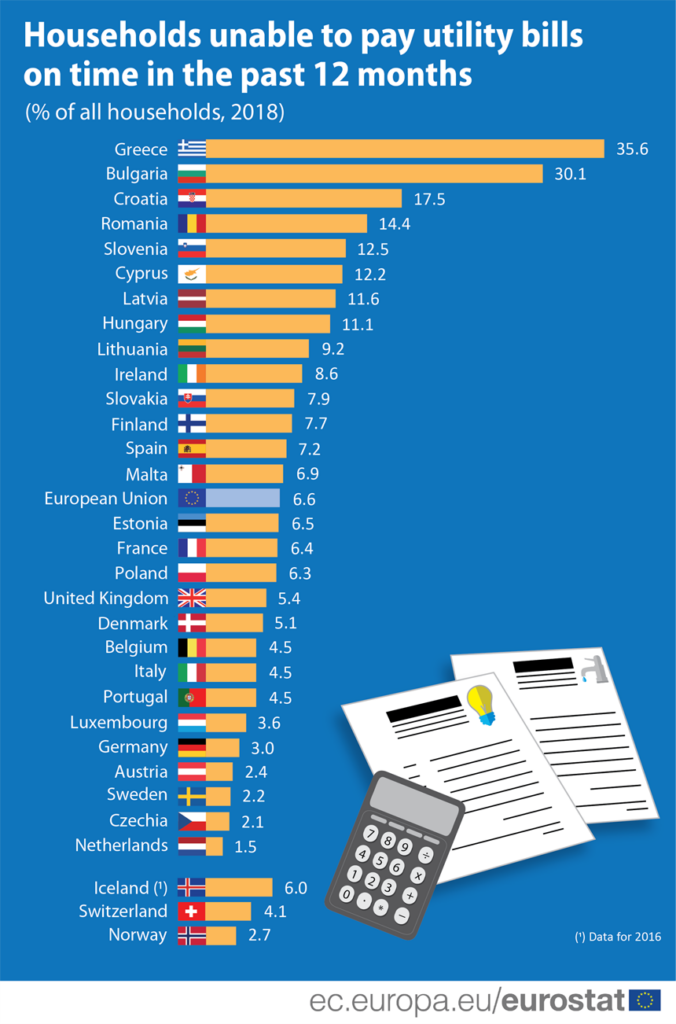Energy poverty is defined as the inability to keep one’s home sufficiently powered and at a pleasant temperature throughout the different seasons of the year. As a complex socio-economic problem, it typically affects the most vulnerable members of society, namely low-income families, single-parent households, the elderly and minorities. Furthermore, individuals living in social housing are disproportionately hit by the problem. At present, it is believed that 10% of Europeans cannot afford to adequately heat their homes in winter and 10% cannot properly cool their homes in the summer. [1]
In light of the current corona crisis, which has resulted in higher unemployment rates, concerns about being able to pay one’s energy bills are likely to rise. Moreover, with policy changes at EU level towards low carbon energy, prices are also destined to increase as cheaper and dirtier energy sources are replaced by costlier, cleaner ones. While this will hit countries across the European Union, the former Communist states of Central and Eastern Europe have already witnessed a substantial increase in energy prices due to the phasing out of subsidies and are still at the beginning of the energy transition.
Although the states of Central and Eastern Europe face the greatest difficulties regarding heating, Southern European countries struggle with the inability to ensure adequate cooling in the summer. Still, energy poverty can be observed across the Union regardless of climatic conditions as illustrated in the diagram below. According to the Right to Energy Coalition, almost 80 million people in the EU were late or could not pay their utility bills in 2019.[2]. Moreover, in 2014, the lowest-income households in the EU spent close 9% of their total expenditure on energy – a 50% increase compared to 2004, highlighting that this problem is becoming more widespread over time.[3]
What is the root cause of energy poverty? It is believed that there are three main factors: low-income levels, high energy prices and the low energy efficiency of buildings. Unfortunately, it is also largely recognised that especially those with low-income levels tend to reside in energy inefficient buildings. Due to a lack of funds and disproportionately high costs, these individuals frequently do not heat/cool their homes properly or only keep some of the rooms in their dwellings at a pleasant temperature. Consequently, these households are confronted with greater mental and physical health concerns than the average population.
Differences across the EU in general poverty rates as well as varying home ownership patterns equally make the tackling of energy poverty in a uniform way challenging. While countries such as Germany lead in terms of rental, in Central and Eastern Europe, private ownership continues to be the norm. In multi-owner buildings, the Homeowner Association must jointly agree to renovate for measures to go ahead. In countries where renting is popular, fair mechanisms must be found to share renovation costs between owners, tenants and the state. This bids for flexibility in the approaches adopted for making renovations more popular.
However, it is undeniable that renovations must play a key role in the combat against energy poverty in the EU. This is because existing buildings account for 36% of CO2 emissions in the Union, a number which can be slashed through energy efficiency measures.[4] Properly renovated housing lowers energy consumption, energy costs and greenhouse gas emissions, constituting a win-win situation. As climate change risks provoking more cold snaps and heat waves across the EU, energy demand levels are expected to rise and thus new and innovative schemes for dealing with energy poverty must be explored to meet both the welfare needs of citizens and those of the earth’s climate.

[1] https://righttoenergy.org/about-energy-poverty/
[2] https://righttoenergy.org/about-energy-poverty/
[3] https://www.europarl.europa.eu/RegData/etudes/STUD/2017/596816/IPOL_STU(2017)596816_EN.pdf
[4] https://ec.europa.eu/info/news/focus-energy-efficiency-buildings-2020-feb-17_en
